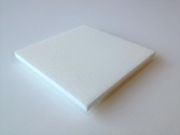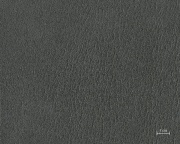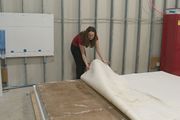Difference between revisions of "Volara"
| (32 intermediate revisions by 2 users not shown) | |||
| Line 1: | Line 1: | ||
| − | [[File:Volara1.jpg|thumb|White Volara | + | [[File:Volara1.jpg|thumb|White Volara <br>Credit: PACCIN]] |
| − | |||
| − | |||
| − | |||
== Description == | == Description == | ||
| − | + | [[File:grey volara.jpg|thumb|Gray Volara <br>Credit Keith Lawrence]] | |
| − | A brand name for a closed | + | [Sekisui Voltek] A brand name for a closed-celled, irradiation cross-linked flexible [[polyethylene|polyethylene]] foam manufactured by [https://www.sekisuivoltek.com/products/volara-polyolefin-foams/ Sekisui Voltek]. Volara has a continuous, smooth surface that is resistant to water absorption, vapor transmission, thermal transmission and chemical reactions. It is available in continuous rolls or laminated sheets that are used to line drawers and boxes. Volara foams have a soft texture with chemical stability, consistent thickness/texture/density, high tensile strength, low water absorption and vapor transmission, good workability, and aesthetic appeal. Volara is primarily used as carpet padding, gaskets and insulation for vehicles and machinery. |
| − | |||
| − | |||
== Synonyms and Related Terms == | == Synonyms and Related Terms == | ||
| − | Volara Foam; Volara type A; | + | Volara Foam; Volara type A; Volara-A; minicel |
| + | Related products:XLPE Foam; X-linked PE Foam; Alveolit (EU); Softion (Japan, Australia) | ||
[[File:1.20.05 10-Removing volara.jpg|thumb|Removing Volara]] | [[File:1.20.05 10-Removing volara.jpg|thumb|Removing Volara]] | ||
| + | == Applications == | ||
| + | * Line boxes, display cases and shelves | ||
| + | * Securing artifacts | ||
| + | * Provide buffer between hard surfaces | ||
| + | * Shim gaps for better fit | ||
| + | * Vibation dampening gasket | ||
| − | == | + | == Personal Risks == |
| − | Volara is | + | Volara is non-toxic and made without any CFC, HCFC, or hydrocarbon blowing agents. |
| − | Volara | + | == Collection Risks == |
| + | Volara is easily soiled with dust and dirt, an once smudged is difficult to clean (PACCIN) | ||
| − | + | '''Links to Oddy Test results posted on AIC Wiki Materials Database Pages for individual materials below''' | |
| − | |||
| − | |||
| − | + | * Voltek [http://www.conservation-wiki.com/wiki/Oddy_Test_Results:_Case_Construction_Materials#Volara0007 Volara] tested in 2016 | |
| − | |||
| − | |||
| − | |||
| − | |||
| − | + | * black [http://www.conservation-wiki.com/wiki/Oddy_Test_Results:_Case_Construction_Materials#Volara0006 Volara] tested in 2016 | |
| − | |||
| − | |||
| − | |||
| − | |||
| − | |||
| − | |||
| − | |||
| − | |||
| − | |||
| − | + | * black [http://www.conservation-wiki.com/wiki/Oddy_Test_Results:_Case_Construction_Materials#Volara0005 Volara] tested in 2013 | |
| − | * | ||
| − | + | * [http://www.conservation-wiki.com/wiki/Oddy_Test_Results:_Case_Construction_Materials#Volara0004 Volara] tested in 2013 | |
| − | + | * 10 year old [http://www.conservation-wiki.com/wiki/Oddy_Test_Results:_Case_Construction_Materials#Volara0003 Volara] tested in 2013 | |
| − | + | * achesive backed [http://www.conservation-wiki.com/wiki/Oddy_Test_Results:_Case_Construction_Materials#Volara0002 Volara] tested in 2013 | |
| − | + | * [http://www.conservation-wiki.com/wiki/Oddy_Test_Results:_Case_Construction_Materials#Volara0001 Volara] tested in 2008 | |
| + | == Environmental Risks == | ||
| + | == Physical and Chemical Properties == | ||
| + | == Working Properties == | ||
| + | Volara has a silky/rubbery texture, pliability and softness at 2 pcf that makes it a useful primary contact material for many unwrapped objectsregardless of whether the surface is flat or curved. Volara can be used alone when rigid support, is desired close to the object, with the main shock-absorption material surrounding the exterior of the rigid securing structure. Note: It has been known to compress and even stick slightly to the bottoms of glass objects left in place over a long period of time.(PACCIN) | ||
| − | + | Volara bonds well with itself and with non-crosslinked PE foams, like Ethafoam and PolyPlank, by heat-welding. With practice, large flat surfaces can be heat-welded without overheating the larger-cell PE foam, which can melt under the heat gun and produce dips in the plane. The thinner forms of Volara are pliable enough to heat-weld onto convoluted surfaces, including custom cavities carved into other PE foams. Volara bonds well with hot glue, but it takes care to ensure that beads of glue do not show through the thin material. Volara also bonds very well with 0.003" double-sided PVC film tape. This tape is useful for attaching Volara to hard, flat materials like foam boards or MDO, where beads of hot glue are more likely to partially dry before lamination and show ridges. Volara is easily cut with a knife - but the blade must be quite sharp to avoid thin bits of "flashing" along the exit edges of the cut. A single slice with the blade will produce a smoother cut than a sawing motion, which can produce a somewhat shredded or faceted appearance. (PACCIN) | |
| − | + | == Forms/Sizes == | |
| − | + | Typically sold in rolls of 60" width: 1/4" sheeting = 300' length; 1/8" sheeting = 600' length, but thicknesses can range from .01" - 0.42" and width of rolls can be up to 88". | |
| − | |||
| − | |||
| − | |||
| − | |||
| − | |||
| − | + | The natural color is white (ivory), but it is also available in 40 colors, including black and grey. | |
| − | |||
| − | == | + | Formulations created for special purposes include: |
| + | * A = The standard formulation used in art handling | ||
| + | * AF = with fire-retardent properties | ||
| + | * AS = with deep-draw vacuum forming capabilities | ||
| + | * EO = with increased flexibility/resiliency/adhesive anchorage | ||
| + | * G = with further increase in EO qualities | ||
| + | * LM = with superior heat stability | ||
| + | * M = with compression-molding capabilities and increased stiffness | ||
| + | * TS = for industrial tapes and gaskets | ||
| + | * RSH = for low pressure molding applications. | ||
| + | * Note that only A, AF, AS, and M are made from polyethylene. The other specialized Volaras are made from alternate polymers. | ||
| − | + | == Resources and Citations == | |
| + | * Sekisui Voltek: [[https://www.sekisuivoltek.com/products/volara-polyolefin-foams/ Website]] | ||
| + | * Rachael Perkins Arenstein, Lisa Goldberg, and Eugenie Milroy, ‘Support and Rehousing for Collection Storage’ In ‘Preventive Conservation: Collection Storage’ Lisa Elkin and Christopher A. Norris (eds.), Society for the Preservation of Natural History Collections, New York. 2019. | ||
| + | * Preparation, Art Handling, Collections Care Information Network (PACCIN) [https://www.paccin.org/content.php?275-Volara-Crosslinked-Polyethylene-Foam Volara] | ||
| + | * National Park System, Conserv O Gram, Number 8/2, 'Safe Plastic & Fabrics for Display & Storage': [https://www.nps.gov/museum/publications/conserveogram/18-02.pdf Link] | ||
* Pam Hatchfield, ''Pollutants in the Museum Environment'', Archetype Press, London, 2002 | * Pam Hatchfield, ''Pollutants in the Museum Environment'', Archetype Press, London, 2002 | ||
| − | |||
* Marie Svoboda, Conservation Survey Index, unpublished, 1997 | * Marie Svoboda, Conservation Survey Index, unpublished, 1997 | ||
| − | |||
* Gordon Hanlon, contributed information, 1998 | * Gordon Hanlon, contributed information, 1998 | ||
| − | |||
* Conservation Support Systems, Catalog, 1997 | * Conservation Support Systems, Catalog, 1997 | ||
| − | + | [[Category:Materials database]] [[Category:MWG]] [[Category:PACCIN]][[Category: Foams]][[Category:Antivibration/Acoustical/Insulation]] | |
| − | [[Category:Materials database]] [[Category:PACCIN]] [[Category: | ||
Latest revision as of 08:14, 13 November 2023
Description
[Sekisui Voltek] A brand name for a closed-celled, irradiation cross-linked flexible Polyethylene foam manufactured by Sekisui Voltek. Volara has a continuous, smooth surface that is resistant to water absorption, vapor transmission, thermal transmission and chemical reactions. It is available in continuous rolls or laminated sheets that are used to line drawers and boxes. Volara foams have a soft texture with chemical stability, consistent thickness/texture/density, high tensile strength, low water absorption and vapor transmission, good workability, and aesthetic appeal. Volara is primarily used as carpet padding, gaskets and insulation for vehicles and machinery.
Synonyms and Related Terms
Volara Foam; Volara type A; Volara-A; minicel
Related products:XLPE Foam; X-linked PE Foam; Alveolit (EU); Softion (Japan, Australia)
Applications
- Line boxes, display cases and shelves
- Securing artifacts
- Provide buffer between hard surfaces
- Shim gaps for better fit
- Vibation dampening gasket
Personal Risks
Volara is non-toxic and made without any CFC, HCFC, or hydrocarbon blowing agents.
Collection Risks
Volara is easily soiled with dust and dirt, an once smudged is difficult to clean (PACCIN)
Links to Oddy Test results posted on AIC Wiki Materials Database Pages for individual materials below
- Voltek Volara tested in 2016
- black Volara tested in 2016
- black Volara tested in 2013
- Volara tested in 2013
- 10 year old Volara tested in 2013
- achesive backed Volara tested in 2013
- Volara tested in 2008
Environmental Risks
Physical and Chemical Properties
Working Properties
Volara has a silky/rubbery texture, pliability and softness at 2 pcf that makes it a useful primary contact material for many unwrapped objectsregardless of whether the surface is flat or curved. Volara can be used alone when rigid support, is desired close to the object, with the main shock-absorption material surrounding the exterior of the rigid securing structure. Note: It has been known to compress and even stick slightly to the bottoms of glass objects left in place over a long period of time.(PACCIN)
Volara bonds well with itself and with non-crosslinked PE foams, like Ethafoam and PolyPlank, by heat-welding. With practice, large flat surfaces can be heat-welded without overheating the larger-cell PE foam, which can melt under the heat gun and produce dips in the plane. The thinner forms of Volara are pliable enough to heat-weld onto convoluted surfaces, including custom cavities carved into other PE foams. Volara bonds well with hot glue, but it takes care to ensure that beads of glue do not show through the thin material. Volara also bonds very well with 0.003" double-sided PVC film tape. This tape is useful for attaching Volara to hard, flat materials like foam boards or MDO, where beads of hot glue are more likely to partially dry before lamination and show ridges. Volara is easily cut with a knife - but the blade must be quite sharp to avoid thin bits of "flashing" along the exit edges of the cut. A single slice with the blade will produce a smoother cut than a sawing motion, which can produce a somewhat shredded or faceted appearance. (PACCIN)
Forms/Sizes
Typically sold in rolls of 60" width: 1/4" sheeting = 300' length; 1/8" sheeting = 600' length, but thicknesses can range from .01" - 0.42" and width of rolls can be up to 88".
The natural color is white (ivory), but it is also available in 40 colors, including black and grey.
Formulations created for special purposes include:
- A = The standard formulation used in art handling
- AF = with fire-retardent properties
- AS = with deep-draw vacuum forming capabilities
- EO = with increased flexibility/resiliency/adhesive anchorage
- G = with further increase in EO qualities
- LM = with superior heat stability
- M = with compression-molding capabilities and increased stiffness
- TS = for industrial tapes and gaskets
- RSH = for low pressure molding applications.
- Note that only A, AF, AS, and M are made from polyethylene. The other specialized Volaras are made from alternate polymers.
Resources and Citations
- Sekisui Voltek: [Website]
- Rachael Perkins Arenstein, Lisa Goldberg, and Eugenie Milroy, ‘Support and Rehousing for Collection Storage’ In ‘Preventive Conservation: Collection Storage’ Lisa Elkin and Christopher A. Norris (eds.), Society for the Preservation of Natural History Collections, New York. 2019.
- Preparation, Art Handling, Collections Care Information Network (PACCIN) Volara
- National Park System, Conserv O Gram, Number 8/2, 'Safe Plastic & Fabrics for Display & Storage': Link
- Pam Hatchfield, Pollutants in the Museum Environment, Archetype Press, London, 2002
- Marie Svoboda, Conservation Survey Index, unpublished, 1997
- Gordon Hanlon, contributed information, 1998
- Conservation Support Systems, Catalog, 1997


